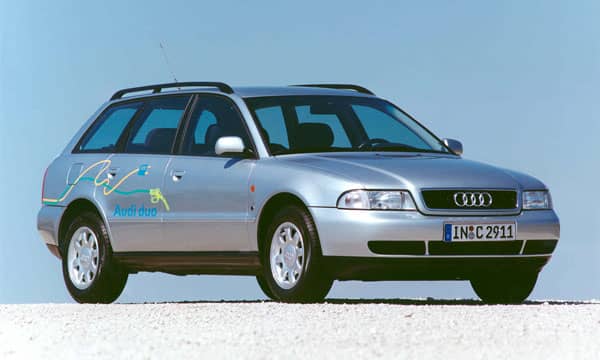Audi unveiled the third generation of the Audi Duo at the International Motor Show in Berlin in mid-September 1996. The basic engineering came from the Audi A4 Avant, equipped with the well-known 66 kW /90 hp four-cylinder TDI and a water-cooled three-phase synchronous motor that delivered 21 kW /29 hp. In contrast to the arrangement on the previous models, here the electric motor was flanged onto the five-speed gearbox, and it also drove the front wheels. The drive shaft of the electric motor extended over a reduction gear directly into the five-speed gearbox. The 320 kilogram lead battery was housed with all of the control equipment in the spare wheel recess and if necessary could be charged via an integrated charger at any household socket. In electric mode, a small electric pump supplied the hydraulics. The steering support, brake servo and ABS worked in the usual way; a fuel-powered auxiliary heater performed the role of the heating system. While travelling on the diesel engine or during braking, the electric motor acted as a generator and charged the battery cells. The capacity of the lead batteries was designed for travelling a distance of approx. 50 urban kilometres. According to a model calculation, in electric mode the fuel costs in urban traffic were DM 2.86 / 100 km, whereas DM 8.40 / 100 km was expected in diesel mode.
Series production was scheduled for September 1997. However, within one model year only 90 vehicles were produced, not least because of the vehicle’s high price of DM 60,000. The time was not yet right for hybrid vehicles.

Technical data
| Engine | In-line 4-cylinder diesel engine with turbocharging, water-cooled three-phase synchronous motor | ||||
| Capacity | 1,896 cc | ||||
| Power |
66 kW /
90 hp
at
4,000 rpm
(diesel engine) 21 kW / 29 hp (electric mode) |
||||
| Top speed |
170 km/h 80 km/h (electric mode) |
||||
| Accleration | 0 – 100 km/h in 7.5 sec | ||||
| Total number built | 90 units | ||||
| Year of manufacture |
|